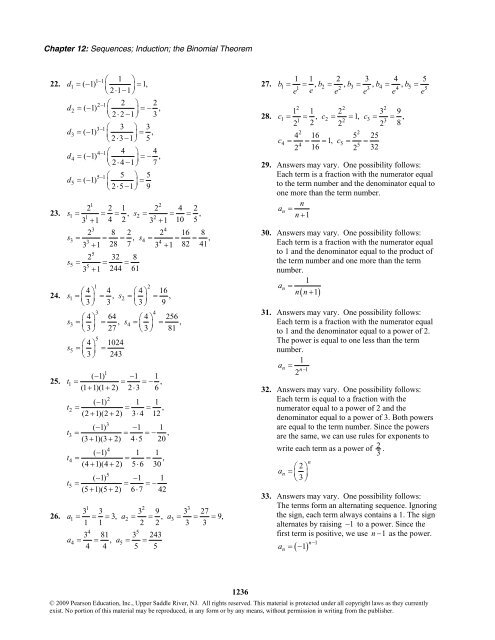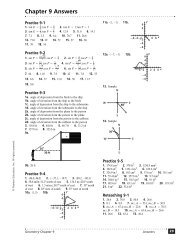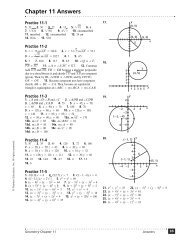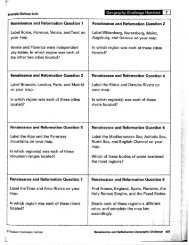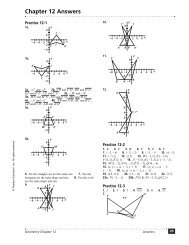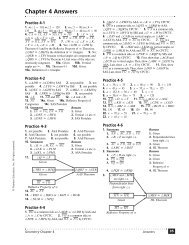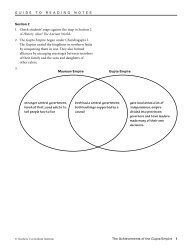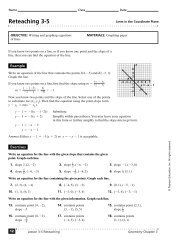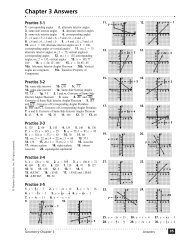Chapter 12 Sequences; Induction; the Binomial Theorem
Chapter 12 Sequences; Induction; the Binomial Theorem
Chapter 12 Sequences; Induction; the Binomial Theorem
You also want an ePaper? Increase the reach of your titles
YUMPU automatically turns print PDFs into web optimized ePapers that Google loves.
<strong>Chapter</strong> <strong>12</strong>: <strong>Sequences</strong>; <strong>Induction</strong>; <strong>the</strong> <strong>Binomial</strong> <strong>Theorem</strong><br />
22.<br />
23.<br />
24.<br />
25.<br />
26.<br />
11 − ⎛ 1 ⎞<br />
d1<br />
= ( − 1) ⎜ ⎟=<br />
1,<br />
⎝21 ⋅ −1⎠<br />
2−1⎛<br />
2 ⎞ 2<br />
d2<br />
= ( − 1) ⎜ ⎟= − ,<br />
⎝2⋅2−1⎠<br />
3<br />
3−1⎛<br />
3 ⎞ 3<br />
d3<br />
= ( − 1) ⎜ ⎟=<br />
,<br />
⎝23 ⋅ −1⎠<br />
5<br />
d<br />
d<br />
4<br />
5<br />
4−1⎛<br />
4 ⎞ 4<br />
= ( − 1) ⎜ ⎟= − ,<br />
⎝2⋅4−1⎠<br />
7<br />
5−1⎛<br />
5 ⎞ 5<br />
= ( − 1) ⎜ ⎟=<br />
⎝25 ⋅ −1⎠<br />
9<br />
1 2<br />
2 2 1 2 4 2<br />
s1 = = = , s<br />
1 2 = = = ,<br />
2<br />
3 + 1 4 2 3 + 1 10 5<br />
s<br />
3 4<br />
2 8 2 2 16 8<br />
= = = , s = = = ,<br />
3 + 1 28 7 3 + 1 82 41<br />
3 3 4 4<br />
s<br />
5 5<br />
5<br />
2 32 8<br />
= = =<br />
3 + 1 244 61<br />
1 2<br />
⎛4⎞ 4 ⎛4⎞<br />
16<br />
s1 = ⎜ ⎟ = , s2<br />
= ⎜ ⎟ = ,<br />
⎝3⎠ 3 ⎝3⎠<br />
9<br />
s<br />
s<br />
3 4<br />
3 4<br />
5<br />
⎛4 ⎞ 64 ⎛4 ⎞ 256<br />
= ⎜ ⎟ = , s = ⎜ ⎟ = ,<br />
⎝3⎠ 27 ⎝3⎠<br />
81<br />
5<br />
⎛4⎞<br />
1024<br />
= ⎜ ⎟ =<br />
⎝3⎠<br />
243<br />
1<br />
( −1) −1 1<br />
t1<br />
= = = − ,<br />
(1+ 1)(1 + 2) 2 ⋅3 6<br />
t<br />
t<br />
t<br />
t<br />
2<br />
3<br />
4<br />
5<br />
2<br />
( −1) 1 1<br />
= = = ,<br />
(2 + 1)(2 + 2) 3⋅4 <strong>12</strong><br />
3<br />
( −1) −1 1<br />
= = = − ,<br />
(3 + 1)(3 + 2) 4⋅5 20<br />
4<br />
( −1) 1 1<br />
= = = ,<br />
(4 + 1)(4 + 2) 5⋅6 30<br />
5<br />
( −1) −1 1<br />
= = =−<br />
(5 + 1)(5 + 2) 6⋅7 42<br />
1 2 3<br />
3 3 3 9 3 27<br />
a1 = = = 3, a2 = = , a3<br />
= = = 9,<br />
1 1 2 2 3 3<br />
a<br />
4 5<br />
3 81 3 243<br />
= = , a = =<br />
4 4 5 5<br />
4 5<br />
1 1 2 3 4 5<br />
e e e e e e<br />
27. b1 = = , b<br />
1 2 = , b<br />
2 3 = , b<br />
3 4 = , b<br />
4 5 = 5<br />
28.<br />
2 2 2<br />
1 1 2 2 3 3<br />
1 1 2 3 9<br />
c = = , c = = 1, c = = ,<br />
2 2 2 2 8<br />
2 2<br />
4 16 5 25<br />
c4 = = = 1, c<br />
4 5 = =<br />
5<br />
2 16 2 32<br />
29. Answers may vary. One possibility follows:<br />
Each term is a fraction with <strong>the</strong> numerator equal<br />
to <strong>the</strong> term number and <strong>the</strong> denominator equal to<br />
one more than <strong>the</strong> term number.<br />
n<br />
an<br />
=<br />
n + 1<br />
30. Answers may vary. One possibility follows:<br />
Each term is a fraction with <strong>the</strong> numerator equal<br />
to 1 and <strong>the</strong> denominator equal to <strong>the</strong> product of<br />
<strong>the</strong> term number and one more than <strong>the</strong> term<br />
number.<br />
1<br />
a n =<br />
n n+<br />
1<br />
( )<br />
31. Answers may vary. One possibility follows:<br />
Each term is a fraction with <strong>the</strong> numerator equal<br />
to 1 and <strong>the</strong> denominator equal to a power of 2.<br />
The power is equal to one less than <strong>the</strong> term<br />
number.<br />
1<br />
a n =<br />
n−1<br />
2<br />
32. Answers may vary. One possibility follows:<br />
Each term is equal to a fraction with <strong>the</strong><br />
numerator equal to a power of 2 and <strong>the</strong><br />
denominator equal to a power of 3. Both powers<br />
are equal to <strong>the</strong> term number. Since <strong>the</strong> powers<br />
are <strong>the</strong> same, we can use rules for exponents to<br />
write each term as a power of 2 3 .<br />
a n<br />
⎛2<br />
⎞<br />
= ⎜ ⎟<br />
⎝3<br />
⎠<br />
n<br />
33. Answers may vary. One possibility follows:<br />
The terms form an alternating sequence. Ignoring<br />
<strong>the</strong> sign, each term always contains a 1. The sign<br />
alternates by raising − 1 to a power. Since <strong>the</strong><br />
first term is positive, we use n − 1 as <strong>the</strong> power.<br />
1<br />
1 n −<br />
= −<br />
a n<br />
( )<br />
<strong>12</strong>36<br />
© 2009 Pearson Education, Inc., Upper Saddle River, NJ. All rights reserved. This material is protected under all copyright laws as <strong>the</strong>y currently<br />
exist. No portion of this material may be reproduced, in any form or by any means, without permission in writing from <strong>the</strong> publisher.


